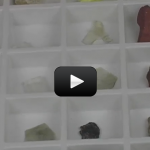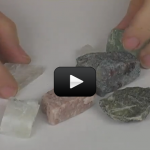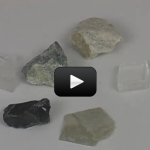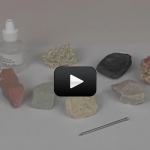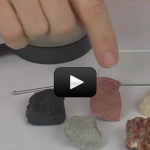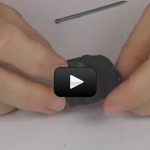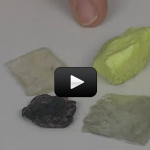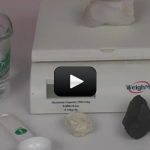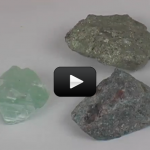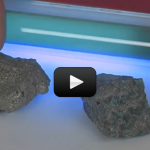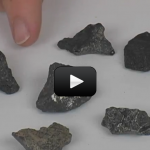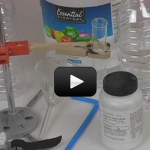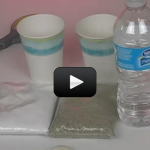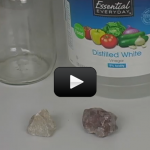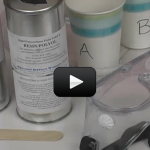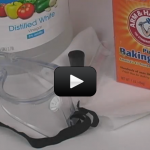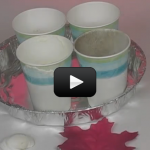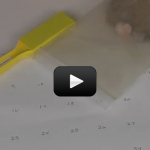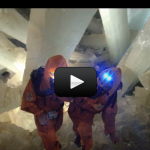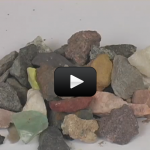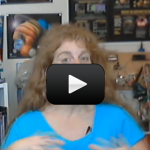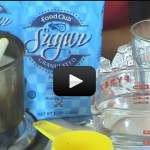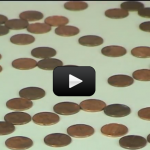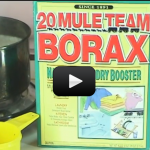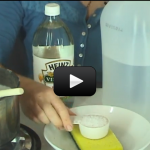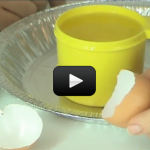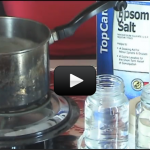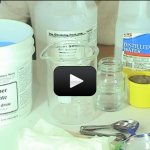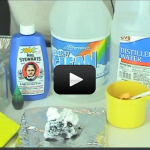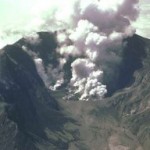Color Streak
You will be able to identify minerals by their colors and streaks, and be able to tell a sample of real gold from the fake look-alike called pyrite. |
Mohs’ Hardness
By the end of this lab, you will be able to line up rocks according to how hard they are by using a specific scale. The scale goes from 1 to 10, with 10 being the hardest minerals. |
Cleavage & Fracture
Today, you’ll learn what to look for in a broken mineral. There are different names for the types of breaks that a mineral can experience. You’ll need to ask a few important questions during your investigation, like, “What is the difference between mineral cleavage and fracture?” |
Acid Test
Your goal is to identify samples according to their reactivity with acid. Minerals that react are called chemical rocks, and minerals that don’t are called clastic rocks. Some chemical rocks contain carbonate minerals, like limestone, dolomite, and marble which react with the acid. |
Sedimentary, Metamorphic, and Igneous Rocks
Clastic rocks come in very different shapes and sizes, but they all have a few characteristics in common. A clast is a grain of sand, gravel, pebble, etc that makes up a rock. Clastic rocks look like they are made up of fragments of other rocks. |
Burning Coal
Bituminous coal (also called black coal) is a soft, black organic sedimentary rock that contains 85% carbon. It’s a lower grade than anthracite coal, which contains 93% carbon. Bituminous coal can either be dull or shiny, whereas anthracite is hard and shiny. Lignite, a lower grade than bituminous, is a crumbly, black type of coal … Continue reading "Burning Coal" |
Tenacity
Tenacity is a measure of how resistive a mineral is to breaking, bending, or being crushed. When you exceed that limit, fracture is how the mineral breaks once the tenacity (or tenacious) limit has been exceeded. |
Density
Density can be found by weighing an object and dividing by the volume of the object, and for geologists, is the same thing as specific gravity. Water has a density of 1, which means that 1 gram of water takes up 1 cubic centimeter of space. Specific gravity is a number you get when you … Continue reading "Density" |
Luster
Luster is the way a mineral reflects light, and it depends on the surface reflectivity. |
Fluorescence
Fluorescent minerals emit light when exposed to ultraviolet (UV) light, usually in a completely different color than when exposed to white light. UV is invisible to the human eye, and is the wavelength of light that is responsible for sunburns. |
Magnetism
A magnetic field is the area around a magnet or an electrical current that attracts or repels objects that are placed in the field. The closer the object is to the magnet, the more powerfully it’s going to experience the magnetic effect. Nearly all minerals that are magnetic have iron as a component. |
Making Limestone
Out of all the kinds of sedimentary rocks, limestone makes up 10% by volume. People have used limestone in architecture like the Great Pyramids, castles in Europe, and in early 20th century buildings like banks and train stations. Today we use it as white filler in toothpaste, to build roads, make tiles, in cosmetics, and … Continue reading "Making Limestone" |
Making Sandstone
Sandstone is a common sedimentary rock that’s composed of quartz crystals cemented together by silica, calcium carbonate, clay or iron oxide. Fossils are often found in sandstone. |
Popcorn Rock
Popcorn rocks are different than regular dolomite samples because they have a lot more magnesium inside. This was first discovered by a geology professor in the 1980s who was dissolving the limestone around fossils he was studying in his rock samples. When he placed samples of this type in the acid to dissolve, it didn’t … Continue reading "Popcorn Rock" |
Foam Pumice
Today we’re making polyurethane foam, which looks a lot like pumice in that it’s lightweight, porous, and cream colored. Polyurethane is a polymer that is used to make a variety of products, including seat cushions, insulation panels, seals and gaskets, roller coaster wheels, escalator rollers, carpet underlay, and wheels for skateboards. |
Test Tube Cannon
You’ll learn about the key ingredient in an explosive eruption like the one we’re simulating in lab today. |
Making Fossils
Today you get to make your own glop of earth that holds an embedded fossil. If you close the dough over the top of the fossil, you can hammer it apart after it’s had two days to dry. |
Geology Field Trip
Field trip time! Today you get to sift through sand and excavate your rock samples right on your own desk. This inexpensive set of rock samples contain pieces of not only fossils and gems, but true minerals and rocks also, so take your time and follow the video instructions carefully. |
Giant Crystals
The Cave of Crystals in Mexico has the world’s largest selenite (gypsum) crystals about 1,000 feet below the surface in a hot cavern. Some of the crystals are over 50 tons in weight and 35 feet in length! |
Rock Hound Workshop
Today you get to sort and identify as many rocks as you can as you test for streak, hardness, fluorescence, color, magnetism, chemical reactions, and more with this unique set of rocks. You may have to do a little research on the ones that are not yet familiar to you! |
Earthquakes!
When two blocks of the Earth slip past each other suddenly, that’s what we call an earthquake! From a physics point of view, earthquakes are a release of the elastic potential energy that builds up. Most energy is released as heat, not as shaking, during an earthquake. 90% of all earthquakes happen along the Ring … Continue reading "Earthquakes!" |
Special Science Teleclass: Renewable & Alternative Energy
This is a recording of a recent live teleclass I did with thousands of kids from all over the world. I’ve included it here so you can participate and learn! Discover the world of clean, renewable energy that scientists are developing today! Explore how they are harnessing the energy of tides and waves, lean how … Continue reading "Special Science Teleclass: Renewable & Alternative Energy" |
Rock Candy Crystals
Crystals are formed when atoms line up in patterns and solidify. There are crystals everywhere — in the form of salt, sugar, sand, diamonds, quartz, and many more! |
Penny Crystal Structure
The atoms in a solid, as we mentioned before, are usually held close to one another and tightly together. Imagine a bunch of folks all stuck to one another with glue. Each person can wiggle and jiggle but they can’t really move anywhere. |
Laundry Soap Crystals
Can we really make crystals out of soap? You bet! These crystals grow really fast, provided your solution is properly saturated. In only 12 hours, you should have sizable crystals sprouting up. |
Salt & Vinegar Crystals
We're going to take two everyday materials, salt and vinegar, and use them to grow crystals by creating a solution and allowing the liquids to evaporate. These crystals can be dyed with food coloring, so you can grow yourself a rainbow of small crystals overnight. |
Eggshell Crystals
Geodes are formed from gas bubbles in flowing lava. Up close, a geode is a crystallized mineral deposit that is usually very dull and ordinary-looking on the outside. |
Salt Stalactites
This is a continuation of the Laundry Soap and Rock Candy experiments, so make sure you've done those before trying this one. |
Water Glass & Metal Crystals
Water Glass is another name for Sodium Silicate (Na2SiO3), which is one of the chemicals used to grow underwater rock crystal gardens. Metal refers to the metal salt seed crystal you will use to start your crystals growing. |
Charcoal Crystals
Charcoal crystals uses evaporation to grow the crystals, which will continue to grow for weeks afterward. You'll need a piece of very porous material, such as a charcoal briquette, sponge, or similar object to absorb the solution and grow your crystals as the liquid evaporates. |
Volcanoes
If you’ve ever wanted to make your own version of a volcano that burps and spit all over the place, then this is the experiment for you. We used to teach kids how to make genuine Fire & Flame volcanoes, but parents weren’t too happy about the shower of sparks that hit the ceiling and … Continue reading "Volcanoes" |

